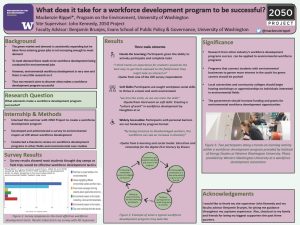What Does It Take for a Workforce Development Program to Be Successful?
As scientists begin to understand more and more information surrounding Earth’s climate and environment, industries and careers in these fields are expanding just as fast. With new policies and green codes and research coming out every day, there becomes a need for new positions and more hands to help fill these positions and the labor force. This summer I attempted to answer the research question of what are the best elements that a workforce development program should have. The way I went about answering this question was administrating a survey to environmental majors at the University of Washington, attending a workforce development convention with my site supervisor, as well as an in-depth independent literature review and research. I discovered that the majority of students had rarely come across environmental workforce programs. I also concluded that programs designed for other industries are successful when they allow participants to work hands on, put emphasis on teaching soft skill, and are accommodating to participants who may have special circumstances, such as being a single parent without childcare or someone who cannot afford transportation. I got to apply this research when I had the privilege to work with 2050 Project on a workforce development program plan to garner more interest in environmental fields amongst Seattle youth. Programs such as these are important to help push younger workers towards environmental careers to continue the expansion and progress of environmental fields. We cannot have innovation or progress without people to push it forward.
